McKinsey's 3 Horizons Framework: Free PowerPoint Template
How to think about growth and innovation? Focus on the Now, New and Next. Free slide deck in PowerPoint and Google Slides format.
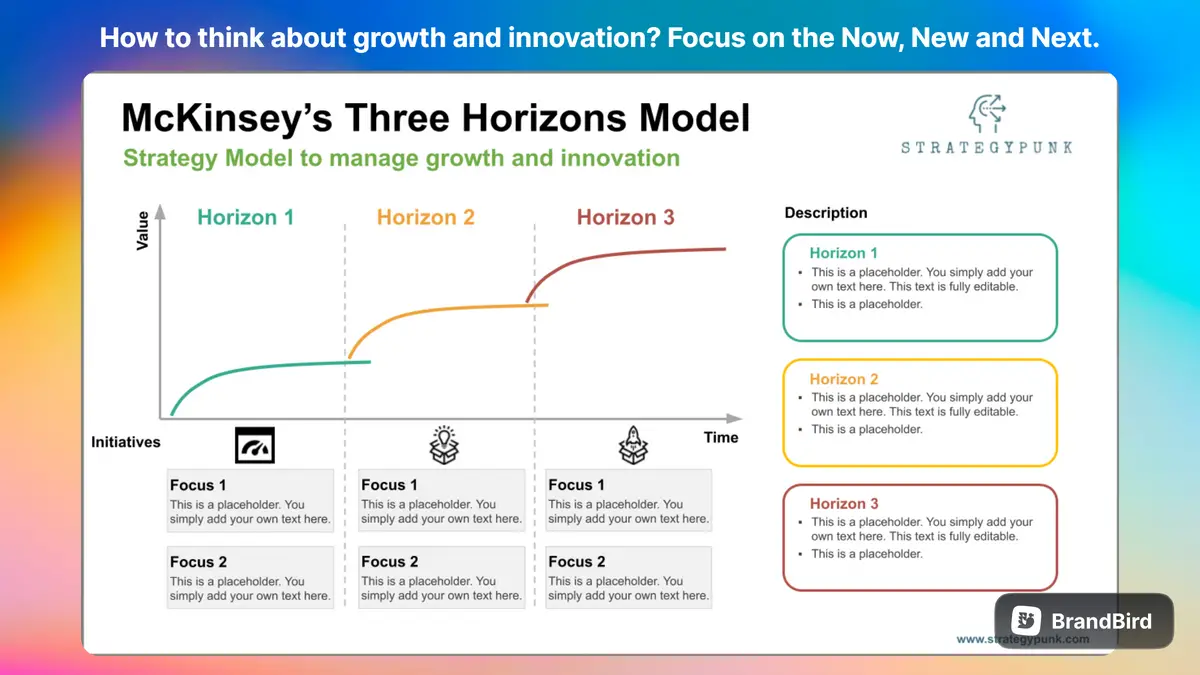
What do you think about the growth and innovation of your organization?
Focus on the Now, New, and Next in your strategic planning. This is a free PowerPoint and Google Slides presentation deck.
Introduction
Are you considering where your business can grow in the next few years? You may have heard of McKinsey’s three-horizon strategy framework, or you may not.
Ultimately, it’s one of the most effective ways for nearly any company to consider growth. A three-horizon framework is a strategic tool rooted in organizational psychology and decision science that aids leaders in understanding which opportunities will significantly impact innovation within their company and how to achieve it.
It’s a relatively simple model with enormous implications for how we think about growth at our companies and find new opportunities for expanding our businesses.
- This blog post covers everything you need to know about the three-horizons framework and why it matters for planning your organization’s future growth.
- At the end of the post, you can download the three-horizons model presentation (in PowerPoint or Google Slides) as a free and fully editable template.
The 3 horizons model
everything you need to know about the model
What is the three-horizons growth framework?
This strategy framework's basic idea is that companies have three growth horizons: - a short-term horizon, a near-term horizon, and a long-term horizon.
Baghai, Coley, and White first articulated the model in The Alchemy of Growth in 2000.
Each horizon represents an opportunity to expand the business by increasing revenue and profit or bringing in new customers.
The idea is that companies capable of focusing on all three horizons simultaneously are more likely to succeed than those that concentrate their efforts solely on one.
The challenge is that companies can easily lose sight of one or two of these horizons as they become absorbed in day-to-day activities.
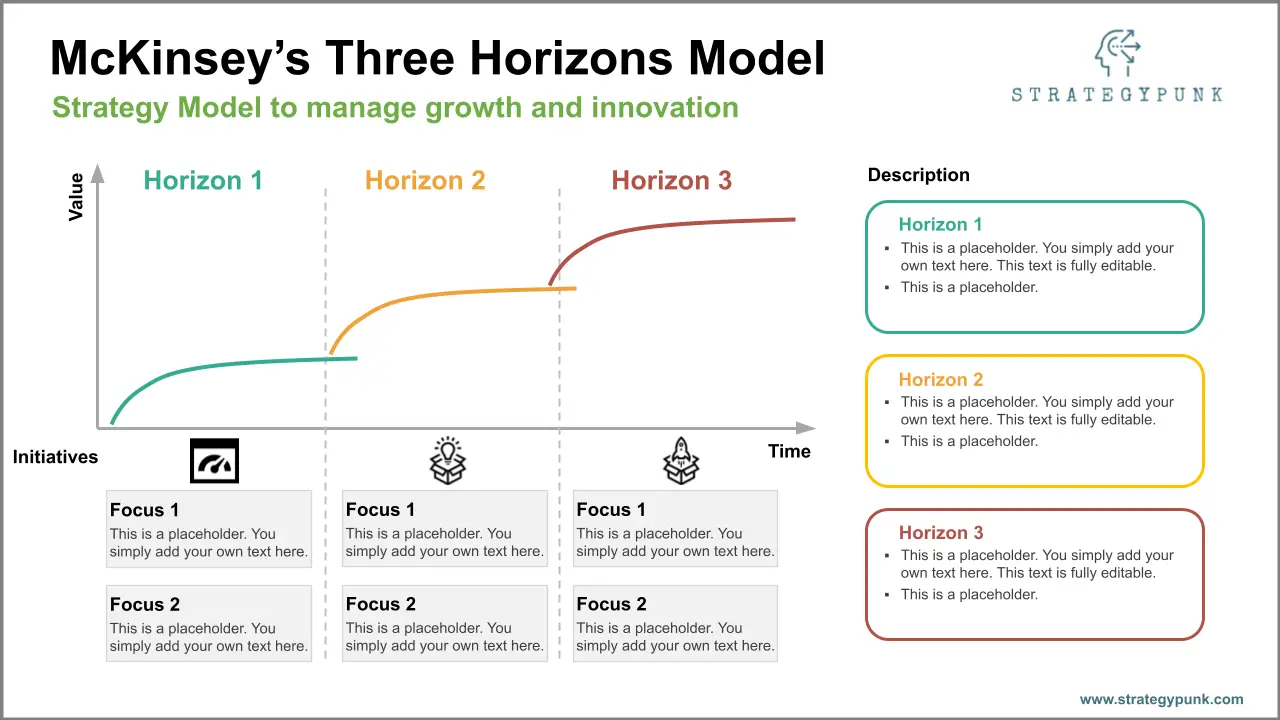
Why should you care about the 3H growth framework?
It is essential to have a growth strategy for your business. But how do you get started?
The 3H growth framework can serve as a valuable guide for engaging the entire company or your team in exploring various opportunities for growth and innovation.
To achieve maximum impact from the 3H framework, leaders should prioritize sharing this mindset with their teams throughout the organization.
Horizon 1: Where to focus to achieve immediate impact (1-3 years)
The first growth horizon is focused on near-term impact and the core business. This is where you’ll find the lowest-hanging fruit that will generate revenue quickly and boost your company’s bottom line.
For example, you can increase sales with your current products or target new customers in your existing markets. You can also stimulate growth by cutting costs and enhancing efficiency. Given this growth horizon, it’s crucial to understand where you’re starting from. Take a close look at your business's current metrics, whether revenue, profitability, or others, and identify the low-hanging fruit that will provide you with an immediate boost.
Once you do, you can focus your team’s energy on tackling the low-hanging fruit and start seeing results quickly.
Horizon 2: Where to invest for near-term growth (2-5 years)
The second horizon of growth is when you can start investing in longer-term growth initiatives. This might involve investing in new products and services, expanding into new markets, or exploring new business models. Some of these initiatives may take longer to reflect in your company’s metrics, but they will be essential for long-term growth.
As you consider this growth horizon, reflect on your business's current state. You may be at a juncture where looking beyond your current markets for new customers makes sense. Additionally, it could be a prime opportunity to concentrate on a specific product line that has experienced growth but remains below expectations.
Horizon 3: Where to focus for long-term growth and future opportunities (5+ years)
This is where the majority of your growth efforts should be focused.
To succeed in this horizon, you’ll need to consider how customers use your company’s products and services, their broader needs, and where new technologies will have the most significant impact.
You should invest in initiatives that will impact your business in the long term, such as finding new ways to connect with customers or expanding into new markets.
Technologies that are likely to have a significant impact in the coming years, like AI, blockchain, and robotics, can also be a good area of focus for this growth horizon.
What is the key to success at each stage?
Focus on the Now, New, and Next
Horizon 1: Superior and Excellent Execution for immediate impact, profitability, and value creation (NOW)
Horizon 2: Positional Advantage to ensure near-term growth and value creation (NEW)
Horizon 3: Insight & Foresight to ensure long-term growth and value creation (NEXT)
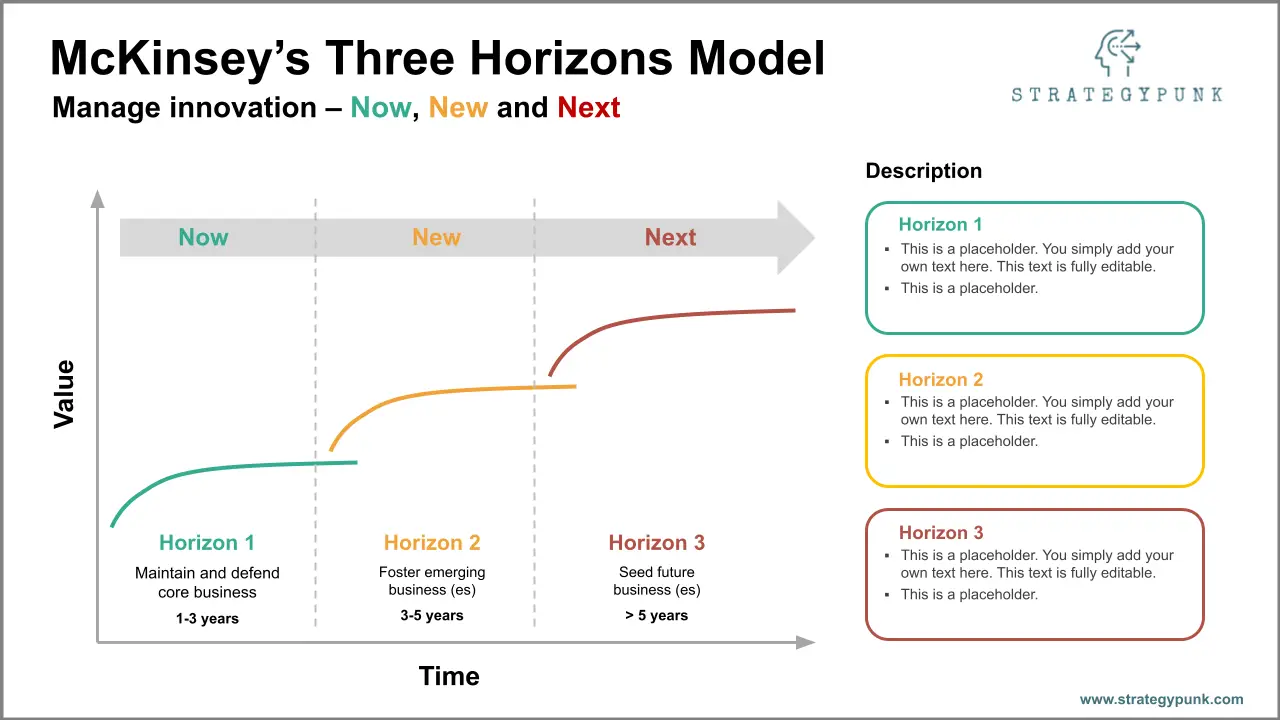
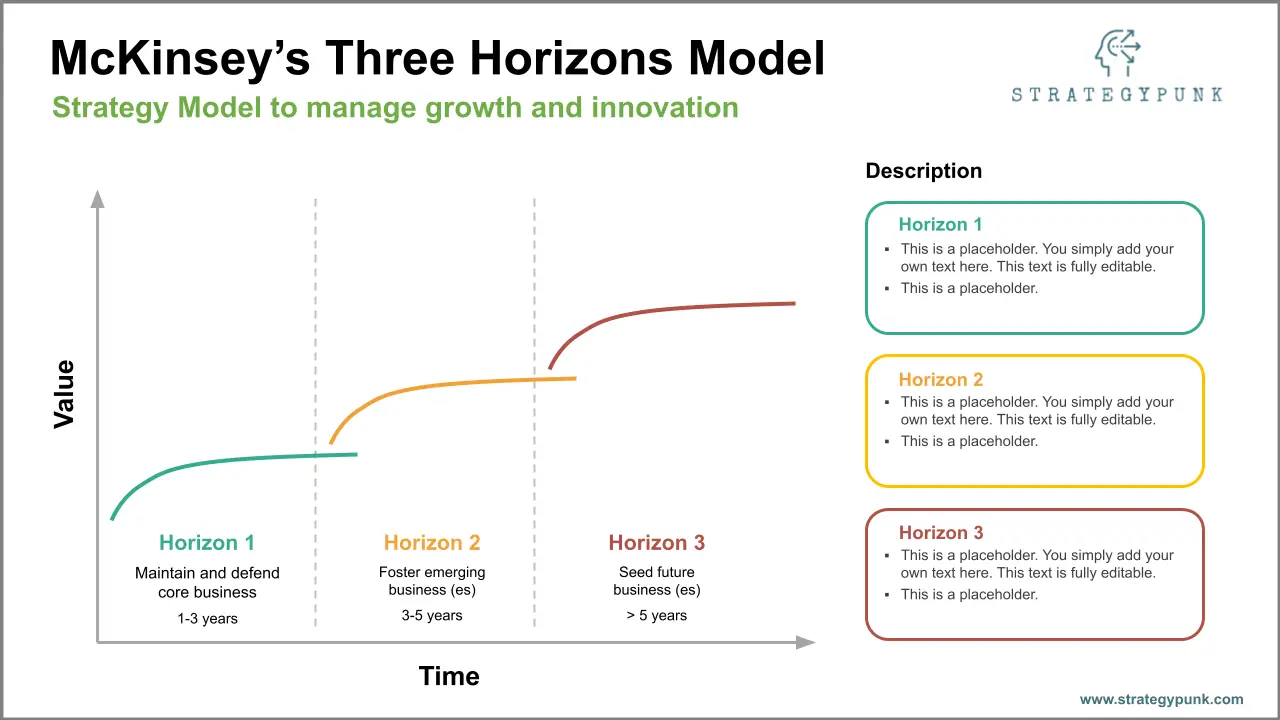
McKinsey Three Horizons Model - Now, New, and Next
Start Reasoning with the Three Horizons
- Assess Current State (Horizon 1)
- Question: Are we optimizing the existing core business effectively?
- Actions:
- Review revenue streams and operational metrics.
- Identify areas for efficiency gains or incremental product improvements.
- Protect market share from competitors.
- Identify Mid-Term Bets (Horizon 2)
- Question: What adjacent or emerging areas could we invest in that will likely scale within a few years?
- Actions:
- Launch pilot programs or test new business models that fit with core capabilities.
- Allocate “growth capital” to the most promising ventures.
- Monitor market and technology trends for near-term shifts.
- Create Future Options (Horizon 3)
- Question: What radical or disruptive innovations could shape our industry in 5+ years?
- Actions:
- Invest in R&D or innovation hubs.
- Encourage a culture of experimentation with new technologies or approaches.
- Evaluate strategic partnerships or acquisitions that position you for future disruption.
Tips for Successful Implementation
- Allocate Resources Wisely: Companies often overlook Horizon 2 and 3. Make deliberate decisions on budgets, staffing, and leadership for each horizon.
- Create Dedicated Teams: Each horizon benefits from a tailored governance structure. H1 typically fits within existing business units, H2 may need “intrapreneurial” teams, and H3 often requires a separate innovation lab or venture arm.
- Measure Differently: Traditional KPIs (e.g., short-term profit, ROI) may not capture the value of emerging opportunities. Adjust metrics to track growth potential, market traction, and learning milestones.
- Foster a Culture of Innovation: Encourage teams to share insights, fail fast, and adopt a long-term view. This cultural foundation is critical for sustaining momentum across all three horizons.
Why the Three Horizons Matter
- Balanced Investment: Ensures that a company doesn’t focus too heavily on short-term performance (Horizon 1) at the expense of medium-term (Horizon 2) or long-term (Horizon 3) growth.
- Structured Risk Management: Each horizon involves different levels of uncertainty and risk. Spreading resources across all three mitigates the danger of obsolescence and supports sustained growth.
- Cultural Alignment: A clear framework can help align internal teams around how and why resources are allocated.
- Leadership Focus: Different horizons require different leadership approaches and mindsets—operational excellence for H1, entrepreneurial discipline for H2, and visionary thinking for H3.
The Criticism of the Three Horizons Model
According to Steve Blank's HBR article 2019, the world nowadays is more dynamic, and the 3-time horizons are no longer constrained by time. In particular, Horizon 3 innovations can disrupt the status quo much faster than initially anticipated, especially when the time horizons are no longer constrained by time.
Today, with all the technological advancements, disruptive Horizon 3 innovations can be delivered as fast as projects for Horizon 1 in the existing product line.
Corporate Use Cases
Toyota
Toyota has effectively implemented the Three Horizons Model to diversify its product portfolio and explore new markets.
Horizon 1 encompasses its core automotive business, while Horizon 2 includes advancements in hybrid and electric vehicles. Horizon 3 reflects Toyota's exploration of innovative mobility solutions, such as autonomous vehicles and connected car technologies.
Key takeaway
McKinsey's Three Horizons growth framework is an effective innovation strategy tool that helps companies consider growth opportunities and where to focus to make the most significant impact.
The first growth horizon is focused on achieving immediate impact, the second on near-term growth, and the third on long-term growth.
Discover our Alternate McKinsey Three Horizons Guides & Templates
Discover our Alternate McKinsey Three Horizons Guides & Templates
Please enhance your strategic planning with our additional content and resources.
McKinsey Three Horizons of Growth: A Strategic Framework for Business Expansion (published April 2023)
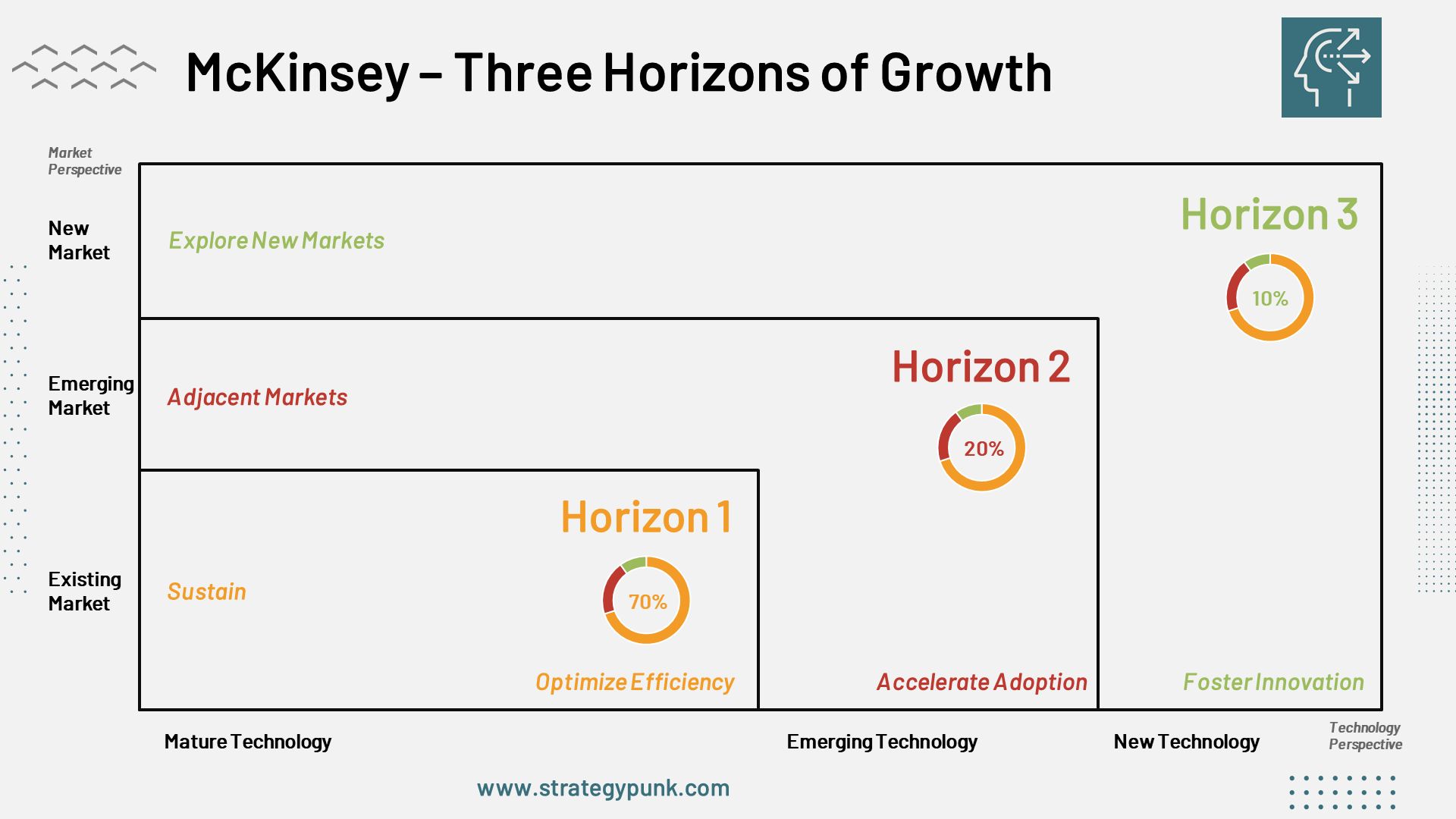
Achieving Balanced Business Grwoth: A Workshop Template on McKinsey's Three Horizons (published May 2023)
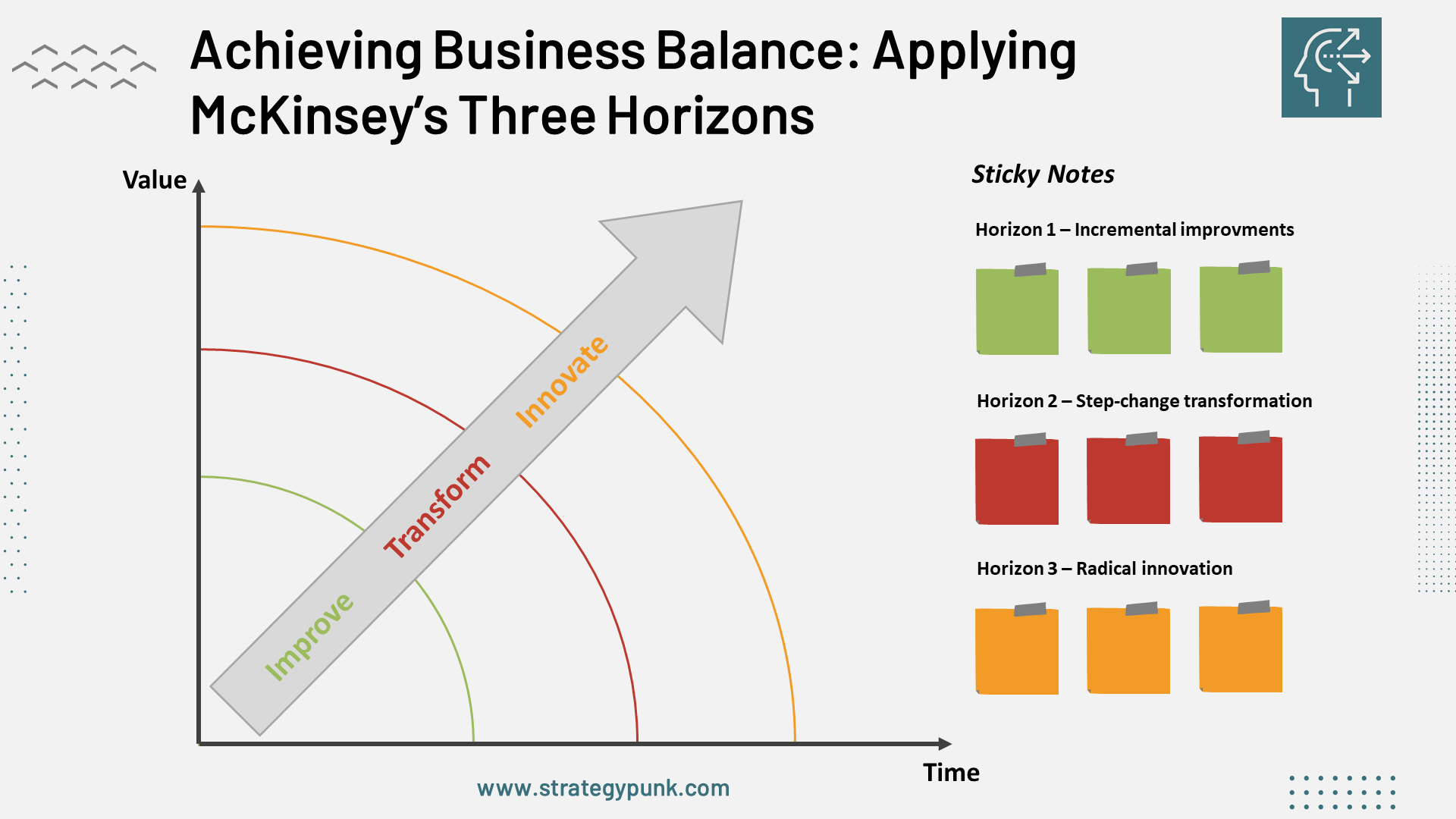
Sustainability and the McKinsey Three Horizons Model: A Path to Eco-Friendly Growth (published May 2023)
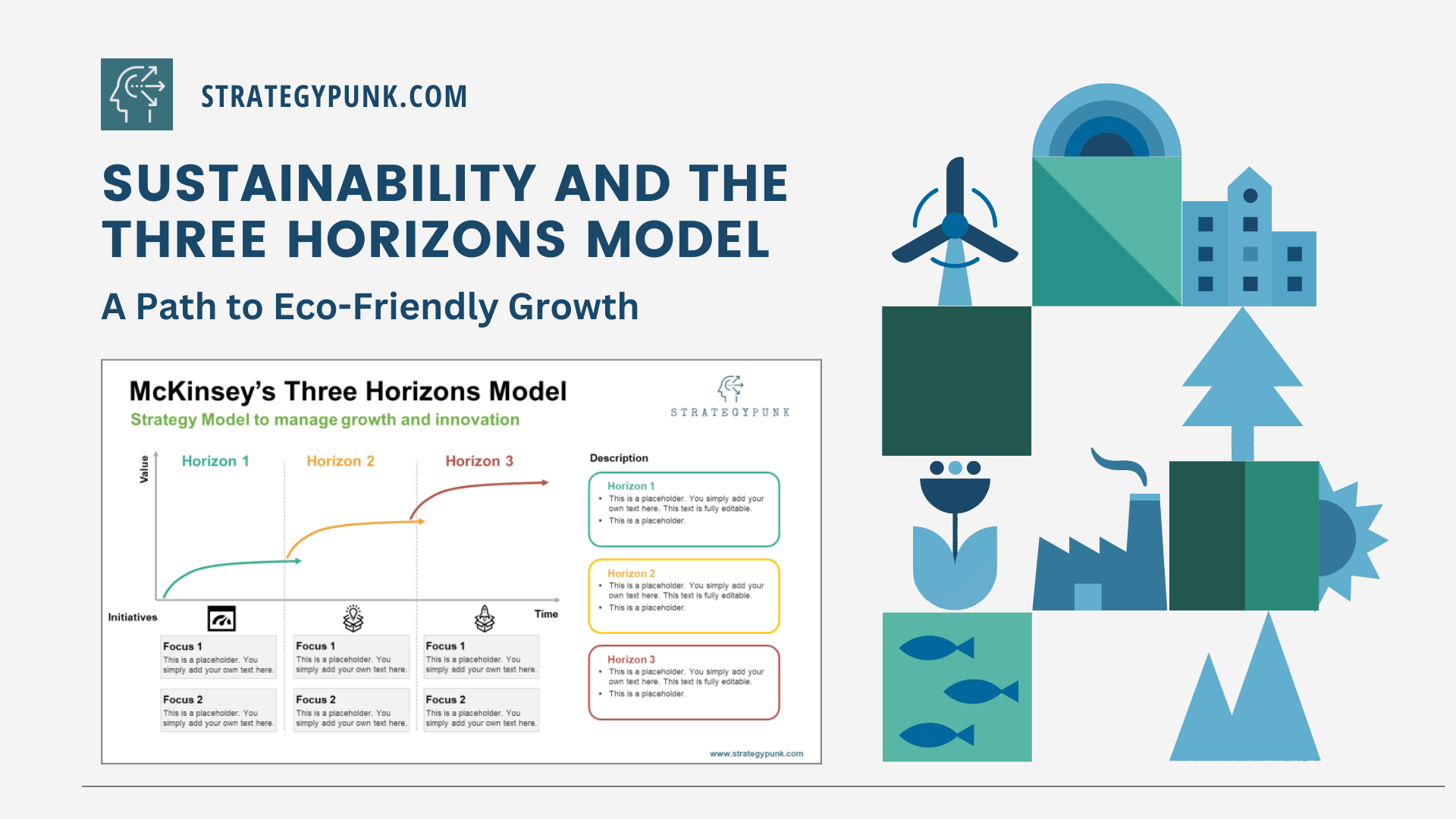
Free Slide Deck / Template
Presentation in PowerPoint and Google Slides format (for subscribers)
Subscribe and login to download the PowerPoint template. It's 100% free and fully editable.
If my content or templates have been valuable and saved you time, consider supporting my work with a small donation. Your support helps me keep creating helpful resources!
Sign up or log in to access your free download below!






